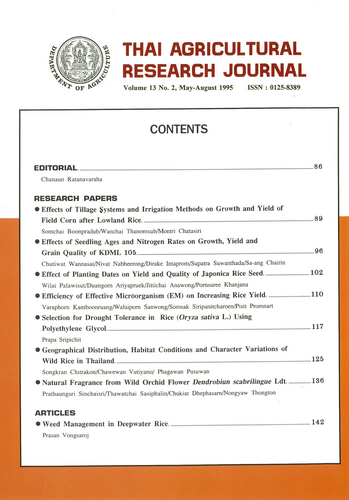Geographical Distribution, Habitat Conditions and Character Variations of Wild Rice in Thailand
DOI:
https://doi.org/10.14456/thaidoa-agres.1995.13Keywords:
wild rice, situationAbstract
A total of 578 passport data of wild rice species collected in thailand were analyzed during 1993-1994 in Pathum Thani Rice Research Center. The objectives were to clarify and elucidate habital conditions and species distribution of Thai wild rice. The characters and geographical distributions of five wild rice species and spontanea forms observed during collection were sumarized as follows :rn1. Oryza rufipogon Griff. A diploid, AA genome with perennial habit. This species was found in open, shallow to deep water throughout Thailand, especially in central plain and southern region. It is taller than one meter and showed floating habit. The panicle was open with hight sterility. The spikelests turned to black and shattered when mature, and possessed long awns and long anthers. Both seeds and tillers from nodes may be the modes of propage propagation. This species is easily crossed with cultivars producting fertile hybrids.rn2. O. nivara Sharma et Shastry. A diploid annual species with the AA genome. It was found mostly in open habitats of north, and northeast region and central plain. Generally it was found in shallow water or moisted land. Its plant type was erect to spreading. Plant height was 80 - 160 cm. It is easily crossed with the cultivars. Seeds have black, long and rigid awns and shattered when mature. It is mainly propagated by seeds.rn3. O. officinalis Wall. A diploid perennial species with CC genome. It is 30-200 cm tall, photoperiod- insensitive with semi-erect plant type. It has long, broad and glabrous leave, open panicles, purple stigmas, small round seeds and short awns. The matured seed was black and shatters freely. This species was found in a wide range of habitats and mostly far away from rice fields. It was unclear what the typical wild habitat of this species is. However, most populations were found under shade in the forest or in orchards. This species, however, has some weedy characteristic such as a high seed production, drough tolerance and ability to withstand disturbed conditions, but is not a weed in rice fields in Thailand.rn4. O. ridleyi Hook. This may be considered as an endangered species due to its rare distribution. It is tetraploidy and perennial. The plant is semi-erect with thick, dark-green and long leaf. There are many secondary branches on one panicle. It has long glumes usually more than half of grain length and dark-red stigmas. It possesses slender grains and short awns. Seed sterility is high. Seed readily shatter at maturity. This species occurs in moist shaded habitats especially near waterfalls in the forest.rn5. O. granulata Nees. (O. meyeriana). This is a shade loving, perennial, diploid and photo-insensitive species. Plant height was about 80 cm. The panicle lacks secondary branching and is compact. Stigma is white, seed set is low and the spikelet has no awn. O. granulata is widely distributed, particulary in the hilly areas of northern Thailand. Several sites of O. granulata populations were found in the northern region.rn6. Spontanea form of O. sativa. This refers to the progenies of hybrid between cultivars and wild relatives or hybrides between wild relatives. Many taxonomists did not consider this type as a distinct species because of large variation and segregation. Japanese scientists called this taxon as intermediate type. They are usually found at the edge or inside rice fields. Due to its vigorous, semi-erect plant type and profuse tillering, It causes a serious weed problems to farmers especially in the central plain and southern regions where broadcasting method is practiced in both deep water and lowland rice fields. Seeds were pubescent with or witout awning. Panicle was big in some cases and showed high percentages of seed setting. The mode of propagation was mainly through seeds which shatter when matured.
Downloads
Published
How to Cite
Issue
Section
License

This work is licensed under a Creative Commons Attribution-NonCommercial-NoDerivatives 4.0 International License.
Thai Agricultural Research Journal



